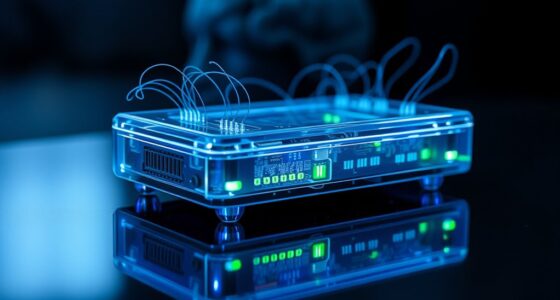Edge computing processes data closer to the source, providing real-time responses with low latency, perfect for IoT applications. In contrast, cloud computing excels in handling large datasets, offering vast storage and powerful analytics for historical data analysis. While edge is best for immediate decision-making, cloud is ideal for intensive data processing without urgent needs. Each has its strengths, and understanding these can help you choose the right solution for your needs—there’s more insight just ahead.
Key Takeaways
- Edge computing processes data locally for real-time responses, while cloud computing handles large-scale data analysis and storage remotely.
- Data latency is minimized with edge computing, allowing instantaneous feedback, whereas cloud computing may introduce delays due to data transmission.
- Cloud computing offers vast storage capacity and scalability, making it ideal for managing large datasets and complex analytics.
- Edge computing is crucial for applications requiring quick decision-making and minimal delays, like smart factories and IoT devices.
- Sustainability is enhanced with edge computing by reducing data transmission needs, while cloud computing may increase bandwidth and energy consumption.

As technology evolves, you might find yourself wondering whether edge computing or cloud computing is the better solution for your needs. Both have their merits, but the choice often boils down to specific use cases, especially when it comes to IoT integration and data latency. With the rise of the Internet of Things, the demand for real-time processing and analysis of data has skyrocketed. This is where edge computing shines. By processing data closer to the source—like sensors or devices—you can dramatically reduce data latency. This means quicker responses to events and improved performance for applications that require immediate feedback.
Imagine you’re managing a smart factory. If you’re relying solely on cloud computing, data from machinery would first be sent to the cloud for processing, then the results sent back to the machines. This round trip can introduce delays that affect efficiency. On the other hand, with edge computing, decisions can be made locally, allowing for real-time adjustments. This is essential for IoT integration, as it enables devices to communicate and respond almost instantaneously.
Managing a smart factory highlights the edge computing advantage, enabling real-time decisions and eliminating latency for efficient operations.
Cloud computing, however, isn’t without its advantages. It offers vast storage capabilities and the ability to analyze large datasets without the constraints of local hardware. If your application involves heavy data processing that doesn’t require immediate action, the cloud could be the way to go. For instance, if you’re analyzing historical trends in consumer behavior, the cloud allows you to leverage powerful analytics tools and machine learning algorithms. In this scenario, data latency isn’t as critical, and the cloud’s scalability becomes an asset.
Moreover, cloud computing excels in scenarios where you need a centralized data repository. For businesses handling massive amounts of data from multiple sources, cloud solutions provide an efficient way to manage and access that data. However, when it comes to IoT integration, the challenge lies in the sheer volume of data generated. Sending all of that data to the cloud can lead to bandwidth issues and increased latency. Additionally, adopting renewable energy sources in your computing strategy can contribute to a more sustainable approach to technology management.
Frequently Asked Questions
What Are the Security Implications of Edge Computing Versus Cloud Computing?
When considering security implications, you’ll find that edge computing often enhances data privacy by processing information closer to its source, reducing exposure during transmission. However, it can introduce vulnerabilities at multiple edge devices. In contrast, cloud computing centralizes data, making threat mitigation easier through robust security protocols, but it can expose large datasets to broader threats. Balancing these factors is vital for your organization’s security strategy, so weigh the risks and benefits carefully.
How Do Latency Issues Differ Between Edge and Cloud Computing?
Latency issues differ substantially between edge and cloud computing. With edge computing, data processing happens closer to the source, reducing latency and improving response times. You’ll experience faster interactions, especially for real-time applications. In contrast, cloud computing relies on centralized data centers, which can increase latency due to network bandwidth limitations and distance. So, if low latency is essential for you, edge computing might be the better choice.
Which Industries Benefit Most From Edge Computing Technology?
If you’re living in the future, edge computing’s already changing the game in industries like manufacturing and healthcare. You’ll see industrial applications thrive with real-time data processing, improving efficiency and safety. In healthcare innovations, the technology enables quicker patient monitoring and faster diagnostics, enhancing overall care. Regions with high data needs benefit most, allowing you to harness the power of data right where it’s generated, cutting down on latency and boosting productivity.
Can Edge Computing Function Without Cloud Computing?
Yes, edge computing can function without cloud computing. In scenarios where local processing is sufficient, devices can operate independently, handling data and making decisions on-site. This independence is vital for applications requiring real-time responses, like autonomous vehicles or industrial automation. By processing data locally, you reduce latency and reliance on external networks. However, integrating cloud resources can enhance capabilities, providing additional storage and processing power when needed.
How Do Costs Compare Between Edge and Cloud Solutions?
When weighing costs, think of edge and cloud solutions like apples and oranges; each has its own flavor. In a cost comparison, edge computing often involves higher upfront expenses due to hardware investments, while cloud solutions usually feature lower initial costs with ongoing subscription fees. Your expense analysis should account for long-term operational costs, as edge may save on bandwidth and latency. Ultimately, the best choice depends on your specific needs and budget.
Conclusion
In the battle of edge computing vs. cloud computing, it’s clear both have their unique strengths. If you need real-time processing and low latency, edge computing’s your go-to, like having a trusty smartphone in your pocket. On the other hand, for scalability and data storage, the cloud shines brighter than a disco ball at a ’70s dance party. Understanding these differences helps you choose the best solution for your needs, ensuring your tech game stays strong and relevant.









